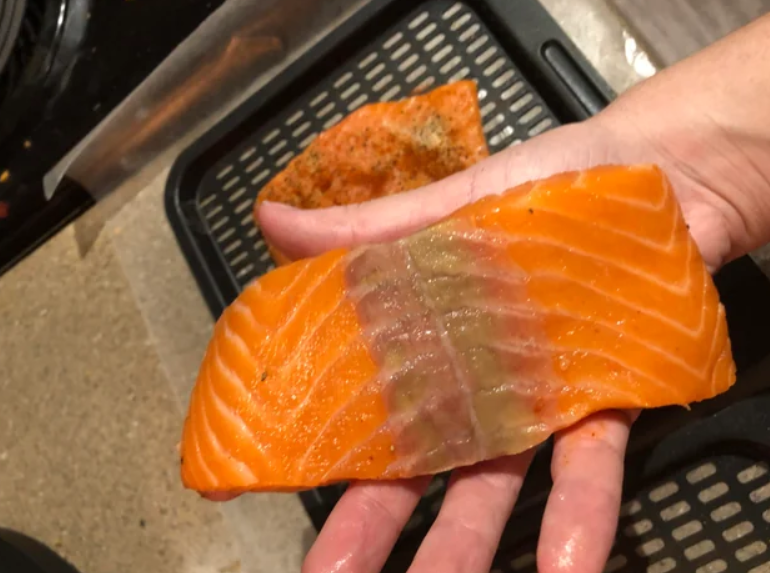Salmon is nutritious and popular but needs careful handling to stay fresh and safe. Properly wrapped, salmon can be frozen for up to three months. Remember to keep salmon away from other foods in your fridge. Separate utensils and cutting boards should also be used to avoid cross-contamination. This helps keep the salmon fresh and safe from foodborne illnesses.
Signs to Look Out For If Cooked Salmon is Bad
Change in color
When cooked salmon goes bad, its color changes. Normally, it has bright red, orange, or pink shades. But if it looks dull, grey, or off in color, it’s probably not safe to eat anymore. Fresh salmon should look vibrant and even in color.
When salmon starts to spoil, its colour fades or looks patchy. You might also see spots or a milky film on it. These signs help us determine whether the salmon is still safe to eat. It’s important to check these things to ensure the fish is safe and tasty.
Bad odor

When checking if cooked salmon is still good to eat, look at its color and then smell it. Freshly cooked salmon should smell mild and slightly salty, like the ocean. If the salmon smells strong, sour, or just bad, it’s probably spoiled.
A sour smell usually means bacteria are growing, and an ammonia smell means the fish is dying. These are clear signs that you should throw the salmon out.
Slimy texture
Checking for a slimy texture on cooked salmon is key to knowing if it’s gone bad. If the salmon feels slimy, it’s usually because of bacteria, and that means it’s not safe to eat. Fresh salmon should feel firm and a bit dry. If it’s slippery or gooey, it’s best to throw it out to avoid getting sick. Make sure to check both the inside and outside of the salmon. Sometimes, the outside looks okay, but the inside is starting to go bad.
Mould growth

If you see mould on cooked salmon, it’s a sure sign it’s gone bad. Mould shows up as ugly green, blue, grey, or black spots. This isn’t just a little problem on the surface.
Mould digs deep into the salmon, making it unsafe to eat even if you try scraping it off. Mould tells you the salmon wasn’t stored right or was kept too long. It’s best to throw out any salmon with mould to keep from getting sick.
Bitter or sour taste
If your cooked salmon tastes bitter or sour, throw it out. That taste means the salmon is bad. When salmon goes bad, bacteria grow, and chemicals change in the fish, making it unsafe to eat. This can cause the fish to produce certain substances that taste really bad. Also, dangerous bacteria like Salmonella or Listeria might be present, which could make you sick. It’s not worth the risk—always throw away salmon that doesn’t taste right.
How to Properly Store and Consume Cooked Salmon?
Store in an airtight container in the fridge
Keep your cooked salmon fresh by storing it in an airtight container. This stops air and moisture from getting in, which can cause bacteria to grow and spoil the fish. Make sure to chill the salmon at or below 40°F right after you cook it. Using a tight container keeps it fresh and stops it from picking up any weird smells or tastes from other foods in the fridge. Always use a clean container that’s safe for food. This way, your salmon should stay good for about 3 to 4 days.
Reheat thoroughly before consuming
When you reheat cooked salmon stored, always heat it to an internal temperature of 165°F. This is important because it kills any bacteria that might have grown while the salmon is stored. To reheat the salmon, use an oven or a stovetop if you can. These methods help preserve the salmon’s texture and flavour. You can also use a microwave, but it might not heat the salmon evenly. Remember to check the temperature with a food thermometer. This will keep you safe from foodborne illnesses and ensure your salmon tastes great when it’s time to eat.
Use within 3-4 days of cooking
To keep cooked salmon safe and tasty, eat it within 3-4 days after making it. Remember to store it right to keep it fresh. Put the salmon in sealed containers and refrigerate them at 40°F or colder as soon as they cool down. This cold temperature stops bacteria from growing, which can make you sick.
Do not leave cooked salmon at room temperature for over two hours. If it’s hot out, like above 90°F, only leave it for one hour. Following these steps will help ensure that your salmon stays safe and healthy.
Conclusion
In short, knowing when cooked salmon has gone bad is crucial to keep yourself safe. Look for any colour changes or rancid smells. Feel the salmon, too; if it’s slimy, that’s not a good sign. Also, watch out for any mould. Tasting it can help you tell if it’s off. Store salmon correctly and eat it soon after cooking to avoid these issues. This way, you dodge the dangers of bad bacteria.

